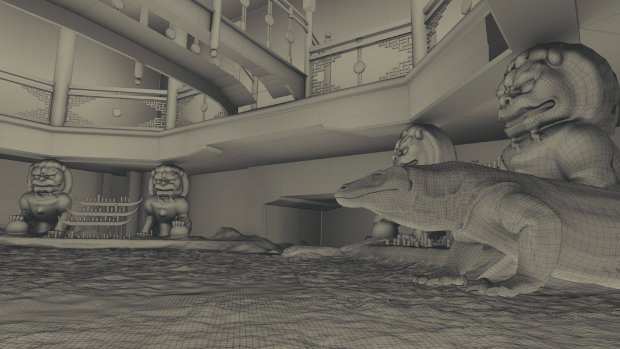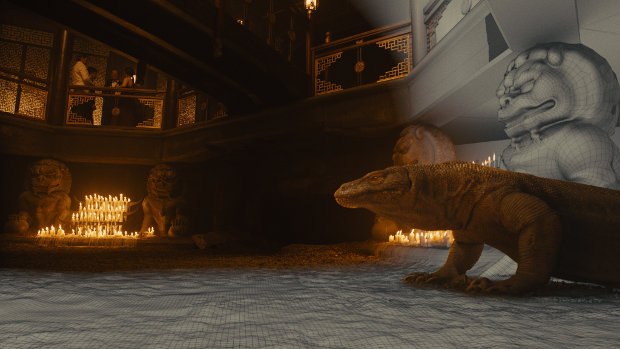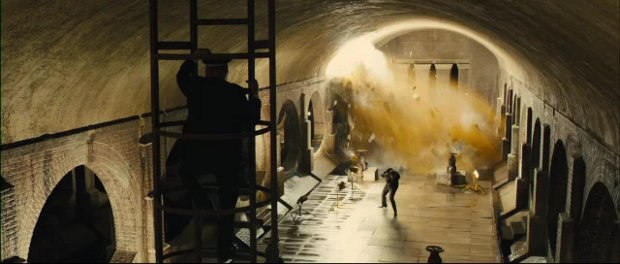Cinesite's Jon Neill discusses creating the first CG character for the Bond franchise along with other VFX mayhem.
In Skyfall, which is breaking box office records for the James Bond franchise in honor of the 50th anniversary, Daniel Craig's 007 loses his mojo. He also has a tense yet humorous skirmish with a Komodo dragon (courtesy of Cinesite), which marks the first CG creature for the franchise.
"They make a big thing about the franchise not being about CG, but I liked the way [Oscar-winning] director Sam Mendes worked," explains Jon Neill, Cinesite's visual effects supervisor. "You can tell he's from the theater the way he would get everyone together, including the technical people, and walk through the whole sequence."
But, of course, Neill didn't have much interaction with Mendes and worked closely with VFX production supervisor Steve Begg. However, the Komodo dragon sequence was quite intimidating, especially given a production that doesn't like CG. "We were lucky being in London with a zoo that has two Komodo dragons," Neill relates. "One was friendly and the other was brought in from the wild, which isn't friendly. So we collaborated with London Zoo and managed to get into an empty room, which is attached to the main enclosure so we could set up all our lights. We painted the walls white and we put white silks on the ceiling and then the Komodo came in via a trap door. We were able to take really nice reference pictures and video with three cameras."
Unfortunately, the dragons looked too clean, so they also took reference photos of Komodos in the wild. Cinesite modeled using Maya, and added texture using Mari, Photoshop and Mudbox, and then composited everything into the live-action plate using Nuke. They enhanced the scene by adding CG dust and gravel that blended in with the pit.
Yet the dragon's interaction with the live-action plate meant lighting and contrast had to be carefully thought through to ensure proper depth of field and that the dragon's shadows were cast correctly in proportion to the actors in the scene. When the animal is shown in close up, it required the loose skin around its neck to react realistically and have the feet interact with the ground.
In addition, having Bond look like he was stepping on the back of a moving Komodo (in homage to jumping over the crocs in Live and Let Die) instead of a static ramp was also challenging, as was the part where the Komodo bites and locks onto the baddie's leg. It was set very close and you couldn't see the dragon’s neck, so there was very little to animate and make interesting. Neill says they concentrated instead on the eye blink and subtle saliva stretching as it opened its mouth. Incidentally, Bond's incredulous look at the first sight of the dragon was Craig's idea.
Cinesite also worked on three other sequences: Bond and baddie Silva (Javier Bardem) sliding down the escalator in the underground system; then up on to the platform where they jump from the back of the train; and then to the catacombs further below the underground system where the explosion occurs and the train crashes into the ceiling.
For the platform chase sequence half a practical train carriage was built by production on set at the Pinewood 007 stage and rigged to travel down the rails while Bond jumps on the back of it. Cinesite was tasked with augmenting the physical effects by extending the carriage using Maya, adding other CG carriages with passengers composited in and adding the train driver into the scene using Nuke. They also did some clean up to provide a seamless look and feel.
Meanwhile, creating a photo-real train that exactly tracked and matched to the physical set piece required a great deal of work. The sharp reflections on a moving train using multi-sampled motion blur pushed up render times but were essential to maximize realism. Also, merging on-set carriages with CG carriages meant seamless integration and realistic reflections had to be precise.
Neill says the catacomb sequence really showcases the franchise's signature mixture of practical effects and stunts. The scene follows Bond as he pursues Silva into the underground network and Silva detonating a bomb, which causes a tube train to come crashing through the scene toward Bond. Cinesite was responsible for a digital set extension to expand the look of the catacomb and to provide added depth. This was accomplished by creating digital matte paintings in Photoshop and projecting them onto a 3D mesh in Nuke to build up the environment and give the perception of extending the archways.
"They had 10 Ari digital cameras [a franchise first] in there hanging from the ceiling, sticking through the floor at all different angles, so every single shot had at least two cameras, which needed to be cleaned up," Neill adds. “When that explosion goes off, Craig was in that scene but the second unit camera crew was in front of Craig and the camera hung from the ceiling looking down, and [cinematographer] Roger Deakins was in front of Craig with a big crew so they covered his legs from the waist down. So we had to use digi-double legs and replace all of the shadows and lighting interaction that came from his feet. In wasn't just a simple case of projecting a matte painting to clean out the camera crew, We had to have lighting interactive matte paintings to get rid of the big dramatic shadows being cast everywhere."
Also, as the train comes crashing down, Cinesite enhanced the 2D practical dust and debris with 3D particles and performed various clean ups to augment the look and feel of the physical set.
"The other thing was as the train was approaching before it crashed through the ceiling, it created a lot of vibrations and the set was shaking as if it was made of plywood, which it was. So you had these brick walls that were crashing so we had to stabilize that and make it solid."
All in a day's work for the Bond crew and the VFX guys.
--
Bill Desowitz is former senior editor of AWN and VFXWorld, the owner of Immersed in Movies (www.billdesowitz.com), a columnist for Thompson on Hollywood at Indiewire and author of James Bond Unmasked (www.jamesbondunmasked.com), which chronicles the 50-year evolution of 007 on screen, featuring interviews with all six actors.




















